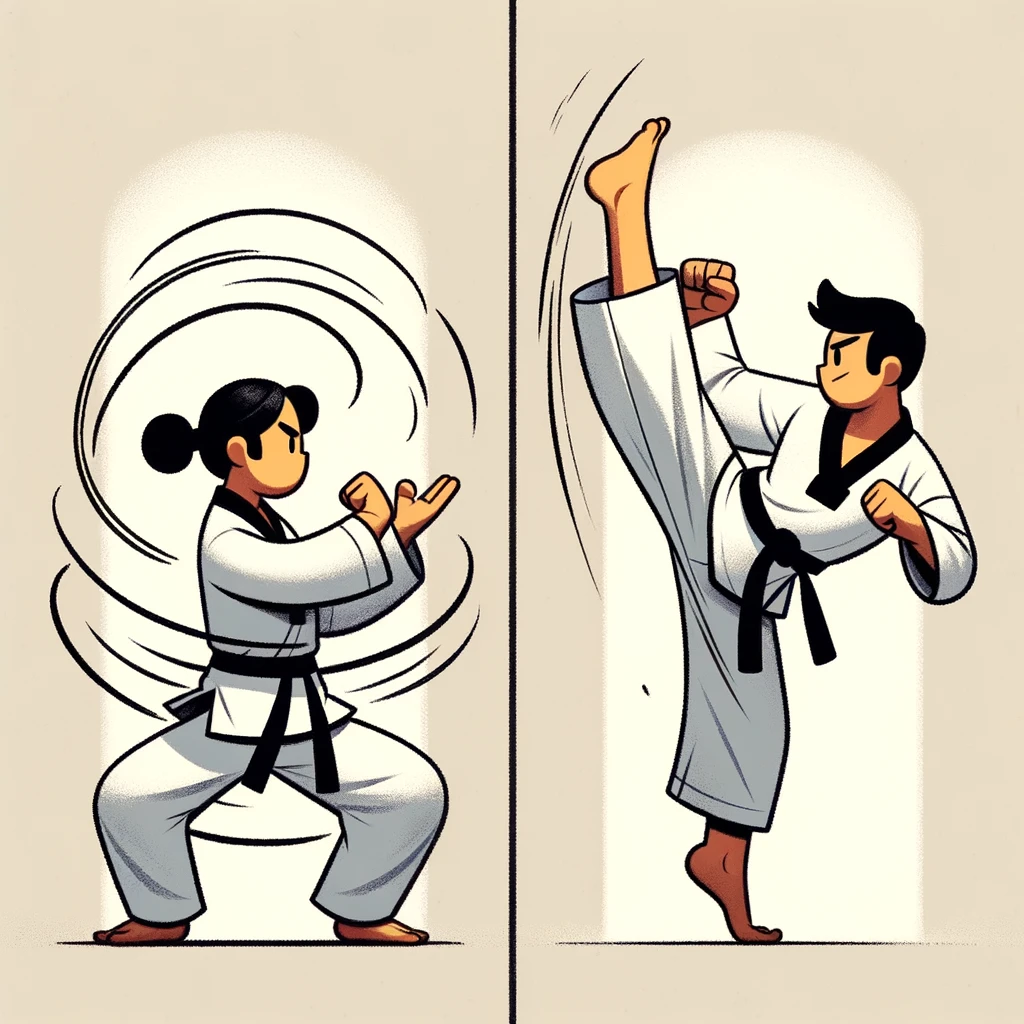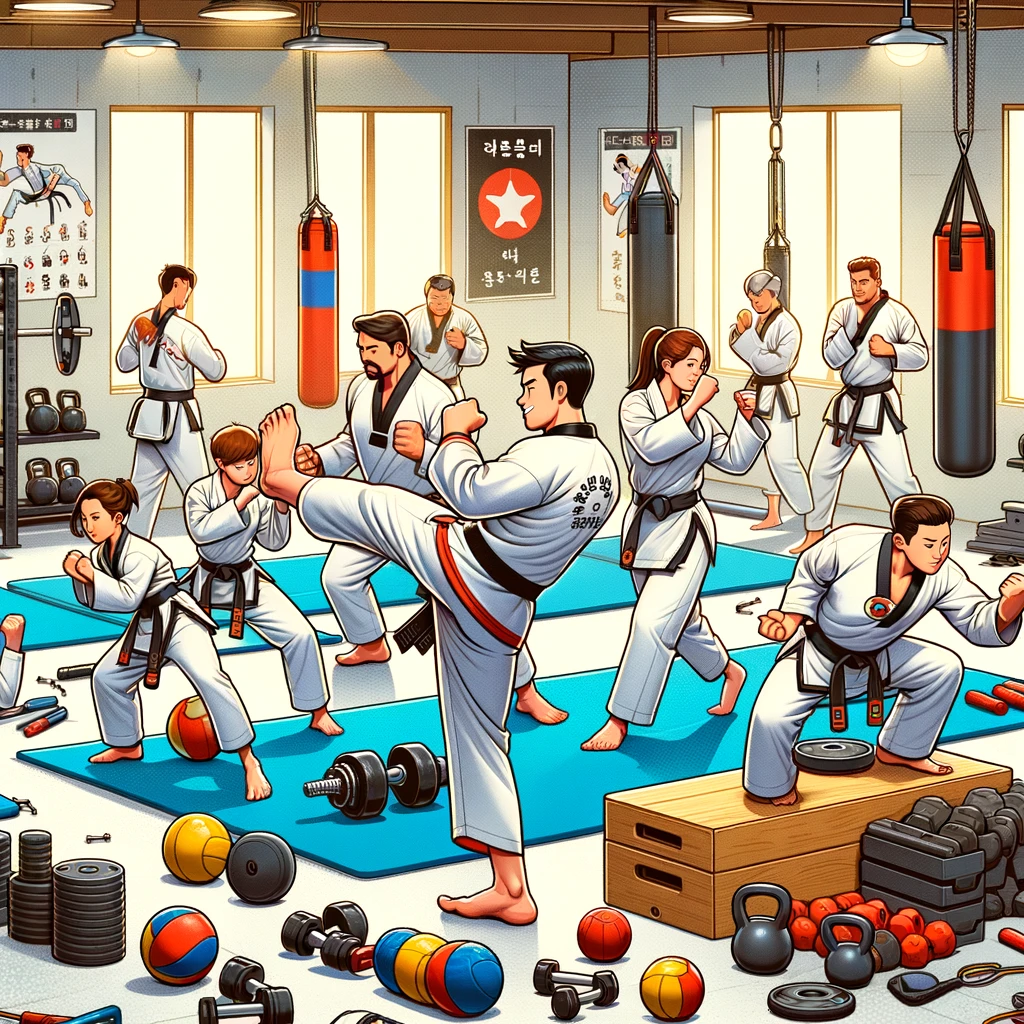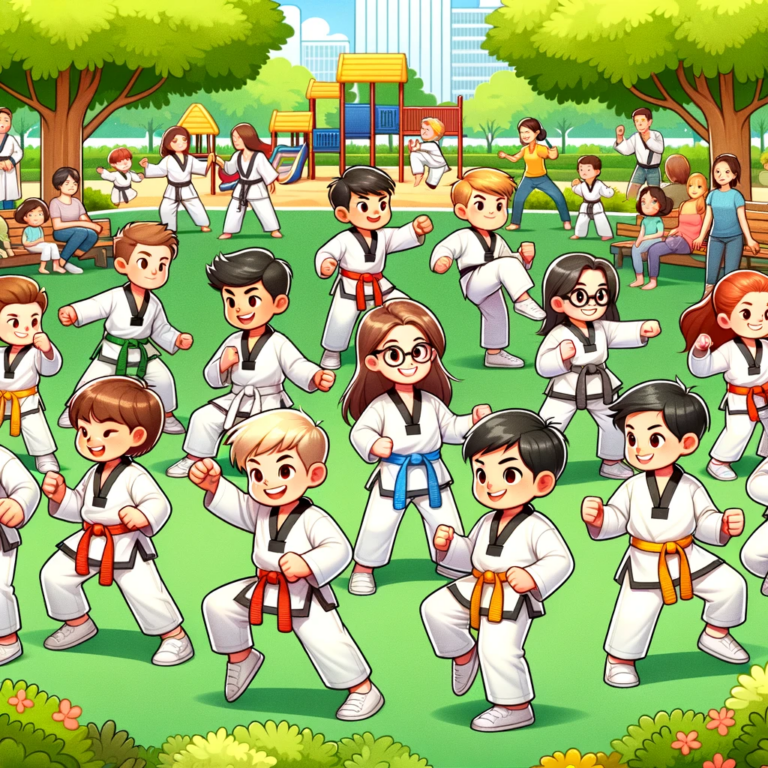The Basics of Taekwondo Kicks
Mastering the Art of Taekwondo Kicks and Understanding the basics of Taekwondo kicks is the cornerstone of any martial arts training, especially in a discipline where the leg and foot are your primary tools against an opponent. The history of Taekwondo reveals a martial art that has evolved significantly, with kicks becoming a defining feature that distinguishes it from other martial arts like Muay Thai. A successful kick in Taekwondo isn’t just about using your leg; it involves your entire body, from the foot blade making contact to the upper body’s role in balance and power generation.
To kick effectively, one must start with the correct fighting stance—feet shoulder-width apart and knees slightly bent, ready to move or kick immediately. This stance allows for quick movements and powerful kicks. Flexibility, balance, and strength are crucial; they enable the practitioner to execute kicks with power and precision, whether aiming for the solar plexus in a front kick or executing a spinning hook kick towards the target. In the following sections, we’ll break down the mechanics of various Taekwondo kicks, emphasising how to align your foot, leg, and body to deliver strikes that are both beautiful and devastating.

Types of Taekwondo Kicks
In Taekwondo, each kick serves a unique purpose, whether for self-defense, competition, or demonstration. Let’s explore some of the fundamental and advanced Taekwondo kicks, focusing on technique, application, and practice tips.
- Front Kick (Ap Chagi): This basic yet powerful kick is performed by lifting the knee towards the target, then snapping the foot out, striking with the ball of the foot. Ideal for hitting the solar plexus or lower targets, the front kick is a staple in self-defense and sparring, emphasizing a straight line attack.
- Roundhouse Kick (Dollyo Chagi): A versatile kick that involves turning the body and swinging the leg in a wide arc to strike the opponent’s side. The foot blade or the top of the foot makes contact. It’s effective at close to medium range and can be aimed at the head, body, or legs.
- Side Kick (Yop Chagi): Executed by turning the body sideways, lifting the knee, and then thrusting the foot sideways with the heel or foot blade aiming towards the target. This powerful kick is perfect for creating distance or targeting the opponent’s side.
- Back Kick (Dwit Chagi): Delivered by looking over the shoulder, lifting the kicking leg straight up, and thrusting it backward towards the target. It’s a surprising move that can catch an opponent off guard, hitting with the heel for maximum impact.
- Hook Kick (Golcha Chagi): Involves swinging the leg in a hooking motion to strike the target with the heel. This kick is excellent for reaching around an opponent’s defence, targeting the head or body.
- Tornado Kick (Bandal Chagi): A spectacular spinning kick that combines turning, jumping, and kicking in one fluid motion. It’s a high-level technique often used in competitions for its impressive appearance and powerful impact.
Practicing these kicks requires dedication and focus. Start slow, paying attention to form and technique, before increasing speed and power. Remember, flexibility and strength are key components of effective kicking, so incorporate stretching and strength training into your martial arts regimen. As you advance, experimenting with combinations and variations will not only improve your skills but also keep your training engaging and fun.

Training Tips for Improved Kicking
Improving your Taekwondo kicks is a journey that requires patience, persistence, and the right approach to training. Here are essential tips to enhance your kicking techniques, making them faster, more powerful, and accurate.
- Warm-up and Stretch Regularly: Flexibility is crucial for high kicks and maintaining a good range of motion. Begin each training session with a thorough warm-up followed by dynamic stretches focusing on the legs, hips, and back. Incorporate yoga or Pilates into your routine to improve flexibility and core strength.
- Strengthen Your Legs and Core: Strong legs and a solid core are the foundation of powerful kicks. Incorporate exercises like squats, lunges, and leg raises into your fitness regimen. Don’t overlook the importance of core strength; planks and sit-ups can significantly enhance your kicking power by providing stability and balance.
- Practice Balance Drills: Balance is key to executing controlled and precise kicks. Practice standing on one foot, gradually extending the other leg in different directions to mimic kicking motions. Use a wall or chair for support initially, working towards maintaining balance without assistance.
- Slow Down to Speed Up: Initially, practice your kicks slowly, focusing on proper form and technique. This slow practice allows you to correct errors and understand each movement’s mechanics. As you become more comfortable, gradually increase your speed while maintaining form.
- Use Equipment: Training with equipment like kicking pads, heavy bags, and speed bags can help improve accuracy, power, and speed. These tools provide resistance and feedback, essential for refining your technique and building confidence in your kicks.
- Record and Review: Video record your training sessions to review your form and technique. This self-assessment tool can be incredibly valuable for identifying areas of improvement and tracking your progress over time.
- Seek Feedback: Work with a coach or experienced practitioner to get constructive feedback on your kicking technique. A fresh set of eyes can offer insights and suggestions that can make a significant difference in your performance.
Consistency is key in martial arts training. Dedicate time each day to practice your kicks, and don’t get discouraged by setbacks. With perseverance and the right approach, you’ll see your Taekwondo kicks improve, enhancing your overall performance and confidence in the art.

Common Mistakes and How to Avoid Them
Even the most dedicated Taekwondo students can fall into common pitfalls when it comes to kicking techniques. Recognizing and correcting these mistakes early can drastically improve your performance and prevent injuries.
- Poor Balance and Posture: A common issue is losing balance or having improper posture during kicks. To avoid this, focus on your standing foot, ensuring it’s firmly planted and pointing in the correct direction to support your body weight. Practice balance exercises and maintain a strong core to enhance stability.
- Overextending the Kick: Kicking too far or without control can lead to overextension, reducing power and leaving you vulnerable to counterattacks. Always kick within your comfortable range of motion, focusing on precision and control. Gradually increase your flexibility and range through consistent stretching.
- Incorrect Foot Positioning: Striking with the wrong part of the foot can lead to ineffective kicks and potential injury. For instance, front kicks should impact with the ball of the foot, not the toes. Practice slow, deliberate kicks, paying close attention to how each part of your foot makes contact with the target.
- Lack of Follow-Through: Some students fail to execute their kicks with enough follow-through, reducing the impact. Ensure each kick is driven by purpose and power, visualizing the force extending beyond the point of contact.
- Neglecting Defense: Focusing too much on offense can leave you open to counterattacks. Incorporate defensive maneuvers into your training, such as retracting your kicking leg quickly after a strike to regain your stance and guard.
- Skipping Warm-ups: Skipping the warm-up phase can lead to stiff muscles and joints, increasing the risk of injury. Always start your training with a proper warm-up and dynamic stretches to prepare your body for the physical activity ahead.
By being mindful of these common mistakes and incorporating the suggested corrections into your practice, you can enhance the effectiveness of your Taekwondo kicks and become a more proficient martial artist. Remember, mastery takes time and patience, so be kind to yourself as you work on perfecting your techniques.

Equipment and Safety
In Taekwondo, as in any martial art, safety should always be a priority to ensure a long and healthy practice. Proper taekwondo equipment and adherence to safety guidelines can significantly reduce the risk of injury and enhance your training experience.
- Protective Gear: Wearing the right protective gear is essential, especially during sparring sessions. This includes headgear, mouthguards, chest protectors, forearm and shin guards, and groin protectors. These pieces of equipment are designed to absorb impact and protect against common injuries.
- Training Mats: Utilize high-quality mats to cushion falls and reduce the impact on your joints during practice. Mats are particularly important when practicing advanced kicks or when learning new techniques that may result in falls or slips.
- Kicking Pads and Heavy Bags: Kicking pads and heavy bags are invaluable tools for practicing your kicks. They provide resistance, which helps build power and allows you to practice striking with full force without the risk of injuring a partner. Ensure these tools are well-maintained and appropriate for your level of strength and skill.
- Proper Footwear: While many Taekwondo practices are done barefoot to improve grip and foot sensitivity, make sure the training area is clean and free of debris. When practicing on rough or outdoor surfaces, wear martial arts shoes to protect your feet.
- Stay Hydrated and Nourished: Physical training can be demanding, so it’s important to stay hydrated and properly nourished. Keep water nearby during your sessions and maintain a balanced diet to support your body’s recovery and performance.
- Listen to Your Body: Pay attention to what your body tells you. If you feel pain or discomfort, take a break and assess the situation. Pushing through pain can lead to serious injuries, setting back your training. Regular rest and recovery are just as important as the training itself.
- Seek Professional Instruction: Especially for beginners, working with a qualified Taekwondo instructor can provide you with the foundation you need to practice safely and effectively. An instructor can correct your form, offer personalized advice, and ensure that you’re progressing at a pace that’s right for you.
By incorporating these safety measures and using the proper equipment, you can enjoy a fulfilling Taekwondo practice while minimizing the risk of injury. Remember, the goal of martial arts training is not only to improve your physical capabilities but also to foster discipline, respect, and a healthy lifestyle.

Applying Taekwondo Kicks in Sparring and Competition
Sparring and competition are where the skills honed in Taekwondo training are put to the test. These environments challenge practitioners to apply their kicks effectively against opponents in dynamic and often unpredictable situations. Here are strategies and insights for utilizing Taekwondo kicks in sparring and competitive settings.
- Understand Distance and Timing: The effectiveness of your kicks in sparring or competition greatly depends on your ability to judge distance and timing accurately. Use front kicks and side kicks to maintain or close distance, and save more complex moves like spinning or jumping kicks for when you’ve created an opening. Practicing with a variety of partners in training can enhance your ability to adapt your timing and distance on the fly.
- Master the Art of Feinting: Feints are a crucial strategy in sparring, allowing you to trick your opponent and create openings for your attacks. A well-executed feint can make the difference between landing a powerful roundhouse kick to the head or missing your opportunity. Incorporate feinting drills into your training to become unpredictable in the ring.
- Control the Fight’s Pace: Use your kicks to control the pace of the fight. Quick front snap kicks or push kicks can keep an aggressive opponent at bay, while fast, powerful combinations can overwhelm a defensive opponent. Adjusting your fighting style based on your opponent’s weaknesses is key to dominating the match.
- Focus on Accuracy and Efficiency: In a competitive setting, landing precise and efficient kicks is more valuable than executing flashy techniques that miss. Focus on targeting vulnerable areas such as the solar plexus, sides, and head. Training with targets and pads can improve your accuracy and ensure that your kicks have the desired impact.
- Analyze and Adapt: Every opponent is different, and what works in one match might not work in another. Stay observant and be ready to adapt your strategy mid-fight. Analyzing professional Taekwondo matches and sparring sessions can provide insights into effective tactics and help you develop a versatile fighting approach.
- Condition Your Body and Mind: The physical and mental demands of sparring and competition are high. Regular conditioning, mental preparation, and visualization techniques can prepare you to face these challenges confidently. Focus on building your endurance, strength, and flexibility, while also cultivating resilience, focus, and strategic thinking.
- Seek Feedback and Reflect: After each sparring session or competition, take the time to reflect on your performance and seek feedback from coaches and peers. Identifying strengths and areas for improvement is crucial for continued growth in Taekwondo.
By applying these strategies, you can leverage the power and versatility of Taekwondo kicks in sparring and competition. Remember, success in martial arts is not just about physical ability but also about strategy, adaptability, and the continual pursuit of excellence.

Embarking on the journey to master Taekwondo kicks is a rewarding endeavor that challenges both the body and mind. Throughout this guide, we’ve explored the foundational techniques of Taekwondo kicks, delved into training tips for improvement, highlighted common mistakes to avoid, discussed the importance of equipment and safety, and provided strategies for applying these skills in sparring and competition. Each step of the way, I’ve shared insights from my personal experience, aiming to inspire and guide you towards becoming a more proficient and confident martial artist.
Taekwondo is more than just a martial art; it’s a path to self-improvement that teaches discipline, respect, and perseverance. The journey is as important as the destination, and every kick practiced, every challenge faced, and every lesson learned contributes to your growth not only as a martial artist but as an individual.
I encourage you to practice regularly, seek continuous improvement, and embrace the lifelong learning that Taekwondo offers. Remember, the art of Taekwondo kicks is not solely about physical prowess but about the harmony between mind, body, and spirit. As you progress, share your journey and experiences with others, fostering a supportive and vibrant Taekwondo community.
Thank you for joining me in exploring the art of Taekwondo kicks. May your training bring you strength, confidence, and joy. Keep kicking, stay dedicated, and let the principles of Taekwondo guide you both in and out of the dojang.
If this guide has sparked your interest in advancing your Taekwondo skills or beginning your martial arts journey, I invite you to join our classes at www.taekwondoschools.co.uk. Follow us on social media for more tips, updates, and inspirational stories from our students and instructors. And, subscribe to our newsletter for exclusive content, upcoming events, and special offers designed to support your Taekwondo journey. Together, let’s kick our way to excellence and embrace the profound journey of martial arts training.







